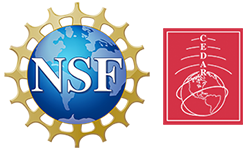2025 Workshop: MESO-KiTS-CEDAR
Jason Derr
Akhtar Ardakani
Anton Artemyev
Bea Gallardo-Lacourt
Gareth Perry
Emma Spanswick
The nightside magnetosphere, or magnetotail, hosts a diverse range of transient mesoscale phenomena, including plasma flows, field-aligned currents, Alfvén waves, thin current sheets, and dipolarization fronts, among others. These dynamic processes are effectively studied using ground-based and low-altitude observations of magnetic field perturbations and energetic particle precipitation into the aurora. Such observations provide a powerful tool for remotely monitoring magnetotail dynamics and assessing their broader impact on the ionosphere and atmosphere.
A comprehensive understanding of these transient events requires the integration of insights from both magnetospheric and aeronomy perspectives. Our session aims to foster collaboration between researchers working with low-altitude and ground-based observations, magnetotail modelers and theoreticians, and those analyzing equatorial spacecraft data. Additionally, we seek contributions from ionospheric and atmospheric modelers to help bridge observational gaps and refine methodologies for tracking magnetotail transients.
All times are approximate:
(10:00-10:05): Jason Derr - Introductory Remarks
(10:05-10:15): Weiqin Sun - Spectra of energetic electrons at low-altitudes: plasma sheet to outer radiation belt transition
(10:15-10:25): Xiaojia Zhang - Exploring Outer Radiation Belt Losses from the International Space Station
(10:25-10:35): Yangyang Shen - Aurora conterpart of fast plasma flows
(10:35-10:45): Natalia Ganushkina - Magnetic mapping during substorm growth phase
(10:45-10:55): Andrei Runov - Relativistic electrons during dipolarizations in the near-Earth PS - link to aurora and ground-based magnetic observations
(10:55-11:05): Sanjay Chepuri - The Partition of Energy Flux Transport at Bursty Bulk Flows
(11:05-11:15): Sheng Tiang - Auroral beads at substorm onset and auroral arcs
(11:15-11:25): Tetsuo Motoba - Link between auroral streamers and geosynchronous dispersionless injections
(11:25-11:35): Shan Wang - Trials on decoding convection from substorm processes with MLT patterns of SMU-SML indices
(11:35 - 11:45): Mike Shumko - What is the relationship between the aurora and relativistic electron precipitation during a storm-time substorm?
(11:45-11:55): Jason Derr - TBD
(11:55-12:00): Discussion
Join ZoomGov Meeting
https://jhuapl.zoomgov.com/j/1609610272?pwd=xZ8JFpo71KVczMaiZ3mKTPq58DOxD8.1
Meeting ID: 160 961 0272
Password: 393432
One tap mobile
+16692545252,,1609610272# US (San Jose)
+16468287666,,1609610272# US (New York)
Dial by your location
+1 669 254 5252 US (San Jose)
+1 646 828 7666 US (New York)
+1 646 964 1167 US (US Spanish Line)
+1 669 216 1590 US (San Jose)
+1 415 449 4000 US (US Spanish Line)
+1 551 285 1373 US (New Jersey)
833 568 8864 US Toll-free
Meeting ID: 160 961 0272
Password: 393432
Find your local number: https://jhuapl.zoomgov.com/u/asBTBaFX3
Join by SIP
Join by H.323
161.199.138.10 (US West)
161.199.136.10 (US East)
Meeting ID: 160 961 0272
Password: 393432
This proposed workshop is highly relevant to both the GEM and CEDAR communities. Our goal is to address the key scientific question: How can we develop methods to monitor magnetotail transients from low-altitude/ground-based observatories and model their impact on the nightside Earth’s ionosphere? To advance toward answering this question, the session will feature short contributed and invited presentations designed to spark discussion within the community. The joint nature of the meeting provides an ideal venue for these debates, fostering discussions between researchers from different areas and facilitating both ongoing and new collaborations.
KiTS Harry Arnold
MESO Bea Gallardo-Lacourt
